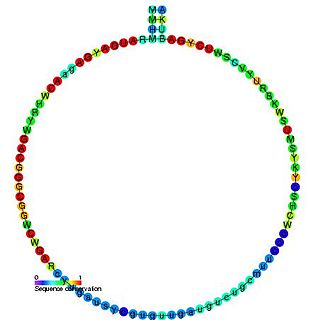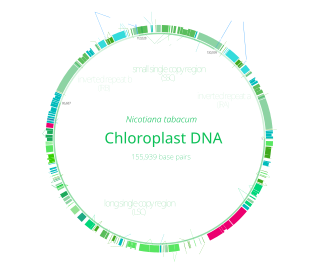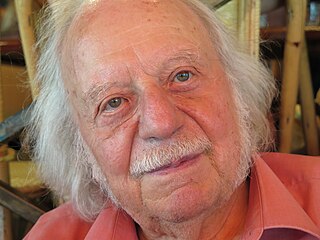Related Research Articles

Arabidopsis (rockcress) is a genus in the family Brassicaceae. They are small flowering plants related to cabbage and mustard. This genus is of great interest since it contains thale cress, one of the model organisms used for studying plant biology and the first plant to have its entire genome sequenced. Changes in thale cress are easily observed, making it a very useful model.

Arabidopsis thaliana, the thale cress, mouse-ear cress or arabidopsis, is a small flowering plant native to Eurasia and Africa. A. thaliana is considered a weed; it is found along the shoulders of roads and in disturbed land.

The transfer DNA is the transferred DNA of the tumor-inducing (Ti) plasmid of some species of bacteria such as Agrobacterium tumefaciens and Agrobacterium rhizogenes(actually an Ri plasmid). The T-DNA is transferred from bacterium into the host plant's nuclear DNA genome. The capability of this specialized tumor-inducing (Ti) plasmid is attributed to two essential regions required for DNA transfer to the host cell. The T-DNA is bordered by 25-base-pair repeats on each end. Transfer is initiated at the right border and terminated at the left border and requires the vir genes of the Ti plasmid.
Florigen is the hypothesized hormone-like molecule responsible for controlling and/or triggering flowering in plants. Florigen is produced in the leaves, and acts in the shoot apical meristem of buds and growing tips. It is known to be graft-transmissible, and even functions between species. Florigen has been found identical to the transcription factor FLOWERING LOCUS T (FT).

In molecular biology, SNORD15 is a non-coding RNA (ncRNA) molecule which functions in the modification of other small nuclear RNAs (snRNAs). This type of modifying RNA is usually located in the nucleolus of the eukaryotic cell which is a major site of snRNA biogenesis. It is known as a small nucleolar RNA (snoRNA) and also often referred to as a guide RNA.

In molecular biology, snoRNA U43 is a non-coding RNA (ncRNA) molecule which functions in the modification of other small nuclear RNAs (snRNAs). This type of modifying RNA is usually located in the nucleolus of the eukaryotic cell which is a major site of snRNA biogenesis. It is known as a small nucleolar RNA (snoRNA) and also often referred to as a guide RNA.
Evolutionary developmental biology (evo-devo) is the study of developmental programs and patterns from an evolutionary perspective. It seeks to understand the various influences shaping the form and nature of life on the planet. Evo-devo arose as a separate branch of science rather recently. An early sign of this occurred in 1999.

Plant evolution is the subset of evolutionary phenomena that concern plants. Evolutionary phenomena are characteristics of populations that are described by averages, medians, distributions, and other statistical methods. This distinguishes plant evolution from plant development, a branch of developmental biology which concerns the changes that individuals go through in their lives. The study of plant evolution attempts to explain how the present diversity of plants arose over geologic time. It includes the study of genetic change and the consequent variation that often results in speciation, one of the most important types of radiation into taxonomic groups called clades. A description of radiation is called a phylogeny and is often represented by type of diagram called a phylogenetic tree.

LTR retrotransposons are class I transposable element characterized by the presence of long terminal repeats (LTRs) directly flanking an internal coding region. As retrotransposons, they mobilize through reverse transcription of their mRNA and integration of the newly created cDNA into another location. Their mechanism of retrotransposition is shared with retroviruses, with the difference that most LTR-retrotransposons do not form infectious particles that leave the cells and therefore only replicate inside their genome of origin. Those that do (occasionally) form virus-like particles are classified under Ortervirales.

Chloroplast DNA (cpDNA) is the DNA located in chloroplasts, which are photosynthetic organelles located within the cells of some eukaryotic organisms. Chloroplasts, like other types of plastid, contain a genome separate from that in the cell nucleus. The existence of chloroplast DNA was identified biochemically in 1959, and confirmed by electron microscopy in 1962. The discoveries that the chloroplast contains ribosomes and performs protein synthesis revealed that the chloroplast is genetically semi-autonomous. The first complete chloroplast genome sequences were published in 1986, Nicotiana tabacum (tobacco) by Sugiura and colleagues and Marchantia polymorpha (liverwort) by Ozeki et al. Since then, a great number of chloroplast DNAs from various species have been sequenced.
Elizabeth Salisbury Dennis is an Australian scientist working mainly in the area of plant molecular biology. She is currently a chief scientist at the plant division of CSIRO Canberra. She was elected a Fellow of the Australian Academy of Technological Sciences and Engineering (FTSE) in 1987, and the Australian Academy of Science in 1995. She jointly received the inaugural Prime Minister's Science Prize together with Professor Jim Peacock in 2000 for her outstanding achievements in science and technology.
WRKY transcription factors are proteins that bind DNA. They are transcription factors that regulate many processes in plants and algae (Viridiplantae), such as the responses to biotic and abiotic stresses, senescence, seed dormancy and seed germination and some developmental processes but also contribute to secondary metabolism.
Circadian Clock Associated 1 (CCA1) is a gene that is central to the circadian oscillator of angiosperms. It was first identified in Arabidopsis thaliana in 1993. CCA1 interacts with LHY and TOC1 to form the core of the oscillator system. CCA1 expression peaks at dawn. Loss of CCA1 function leads to a shortened period in the expression of many other genes.

Klaus Scherrer is a French biologist of Swiss nationality. He is emeritus research director for the CNRS, member of EMBO, member of the academia Europaea and the Brazilian academy of sciences. He is Professor honoris causa of University of Brasilia.
LUX or Phytoclock1 (PCL1) is a gene that codes for LUX ARRHYTHMO, a protein necessary for circadian rhythms in Arabidopsis thaliana. LUX protein associates with Early Flowering 3 (ELF3) and Early Flowering 4 (ELF4) to form the Evening Complex (EC), a core component of the Arabidopsis repressilator model of the plant circadian clock. The LUX protein functions as a transcription factor that negatively regulates Pseudo-Response Regulator 9 (PRR9), a core gene of the Midday Complex, another component of the Arabidopsis repressilator model. LUX is also associated with circadian control of hypocotyl growth factor genes PHYTOCHROME INTERACTING FACTOR 4 (PIF4) and PHYTOCHROME INTERACTING FACTOR 5 (PIF5).
Arabidopsis thaliana is a first class model organism and the single most important species for fundamental research in plant molecular genetics.

Micropeptides are polypeptides with a length of less than 100-150 amino acids that are encoded by short open reading frames (sORFs). In this respect, they differ from many other active small polypeptides, which are produced through the posttranslational cleavage of larger polypeptides. In terms of size, micropeptides are considerably shorter than "canonical" proteins, which have an average length of 330 and 449 amino acids in prokaryotes and eukaryotes, respectively. Micropeptides are sometimes named according to their genomic location. For example, the translated product of an upstream open reading frame (uORF) might be called a uORF-encoded peptide (uPEP). Micropeptides lack an N-terminal signaling sequences, suggesting that they are likely to be localized to the cytoplasm. However, some micropeptides have been found in other cell compartments, as indicated by the existence of transmembrane micropeptides. They are found in both prokaryotes and eukaryotes. The sORFs from which micropeptides are translated can be encoded in 5' UTRs, small genes, or polycistronic mRNAs. Some micropeptide-coding genes were originally mis-annotated as long non-coding RNAs (lncRNAs).
Jian-Kang Zhu is a plant scientist, researcher and academic. He is a Senior Principal Investigator in the Shanghai Center for Plant Stress Biology, Chinese Academy of Sciences (CAS). He is also the Academic Director of CAS Center of Excellence in Plant Sciences.

RNA-directed DNA methylation (RdDM) is a biological process in which non-coding RNA molecules direct the addition of DNA methylation to specific DNA sequences. The RdDM pathway is unique to plants, although other mechanisms of RNA-directed chromatin modification have also been described in fungi and animals. To date, the RdDM pathway is best characterized within angiosperms, and particularly within the model plant Arabidopsis thaliana. However, conserved RdDM pathway components and associated small RNAs (sRNAs) have also been found in other groups of plants, such as gymnosperms and ferns. The RdDM pathway closely resembles other sRNA pathways, particularly the highly conserved RNAi pathway found in fungi, plants, and animals. Both the RdDM and RNAi pathways produce sRNAs and involve conserved Argonaute, Dicer and RNA-dependent RNA polymerase proteins.

Wojciech Maciej Karlowski is a Polish biologist specializing in molecular biology and bioinformatics, and a full professor in biological sciences. He is Head of the Department of Computational Biology at the Faculty of Biology at the Adam Mickiewicz University in Poznan. His major scientific interests include identification of non-coding RNAs, genomics, high-throughput analyses, and functional annotation of biological sequences.
References
- ↑ "Linkedin".
- ↑ "Centre Pilote La Main à la pâte de Perpigan".
- ↑ "Maison pour la sciences Toulouse".
- ↑ "La Main à la pâte".
- ↑ "Google Scholar".
- ↑ M.Delseny et al., « Détection de séquences polyriboadényliques dans les ARN de Radis », C.R. Acad. Sci., Série D, (1974), 278, p. 1225-1228
- 1 2 M. Delseny and R. Hull, « Isolation and characterization of faithful and altered clones of the genomes of cauliflower mosaic virus isolates Cabb B-JI, CM4-184, and Bari I », Plasmid, (1983), 9, p. 31-41
- 1 2 M. Delseny et al., « Sequences heterogeneity in radish nuclear ribosomal RNA genes », Plant Sci. Letters, (1983), 30, p. 107-111
- ↑ F. Grellet et al., « Organization and evolution of a higher plant alphoïd like satellite DNA sequence », J. Mol. Biol., (1986), 187, p. 495-507
- ↑ D. Delcasso-Tremousaygue et al., « Structural and transcriptional characterization of the external spacer of a ribosomal RNA nuclear gene from a higher plant », Eur. J. Biochem., (1988), 172, p. 767-776
- ↑ R. Cooke et al., « Further progress towards a catalogue of all Arabidopsis genes : analysis of a set of 5000 non-redundant ESTs », Plant J., (1996), 9, p. 101-124
- ↑ Salanoubat et al., « Sequence and analysis of chromosome 3 of the plant Arabidopsis thaliana », Nature, (2000), 408, p. 820-822
- 1 2 G. Blanc et al., « Extensive duplication and reshuffling in the Arabidopsis thaliana genome », Plant Cell, (2000), 12, p. 1093-11
- ↑ M. Delseny, « Towards an accurate sequence of the rice genome », Current Opinion in Plant Biol., (2003), 6, p. 101-105
- ↑ J. Sallaud et al., « High Throughput T-DNA Insertion Mutagenesis in Rice : A First Step towards in silico Reverse Genetics », Plant J., (2004), 39, p. 450-464
- ↑ J. Salse et al., « Identification and characterization of shared duplications between rice and wheat provide new insight into grass genome evolution », Plant Cell, (2008), 20, p. 11-24
- ↑ C. Lopez et al., « A unigene catalogue of 5700 expressed genes in Cassava (Manihot esculenta) », Plant Mol Biol, (2004), 56, p. 541-554
- ↑ E. Derelle et al., « Genome analysis of the smallest free-living eukaryote Ostreococcus tauri unveils many unique features », Proc Natl Acad Sc USA, (2006), 103, p. 11647-11652
- ↑ F. Parcy et al., « Regulation of gene expression programs during Arabidopsis seed development : roles of the ABI3 locus and of endogenous abscisic acid », The Plant Cell, (1994), 6, p. 1567-1582
- ↑ N. Bies-Etheve et al., « Inventory, evolution and expression profiling diversity of the LEA (Late Embryogenesis Abundant) protein gene family in Arabidopsis thaliana », Plant Mol Biol, (2008), 67, p. 107-112
- ↑ L. Sossountzov et al., « Spatial and temporal expression of a maize lipid transfer protein gene », The Plant Cell, (1991), 3, p. 923-933
- ↑ A. Ronceret et al., « Genetic analysis of two Arabidopsis DNA polymerase epsilon subunits during early embryogenesis », Plant J, (2005), 44, p. 223-236
- ↑ C .Carles et al., « Regulation of Arabidopsis thaliana Em genes: role of ABI5 », Plant J, (2002), 30, p. 1-13
- ↑ F. Bourgis et al., « Characterization of the major fragrance gene from an aromatic japonica rice and analysis of its diversity in Asian cultivated rice », Theor Appl Genet, (2008), 117, p. 353-368
- ↑ R. Blanvillain et al., « The Arabidopsis peptide KISS OF DEATH is an inducer of Programmed Cell Death », EMBO J, (2011), 30, p. 1173-1183
- 1 2 "Biographie Michel Delseny" (PDF). academie-sciences.fr.
- 1 2 "Journal officiel".